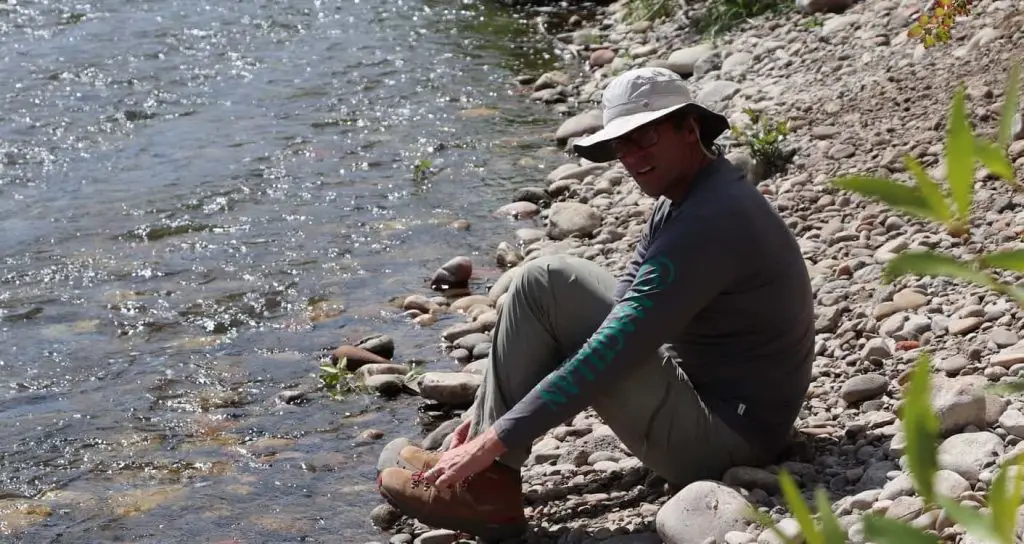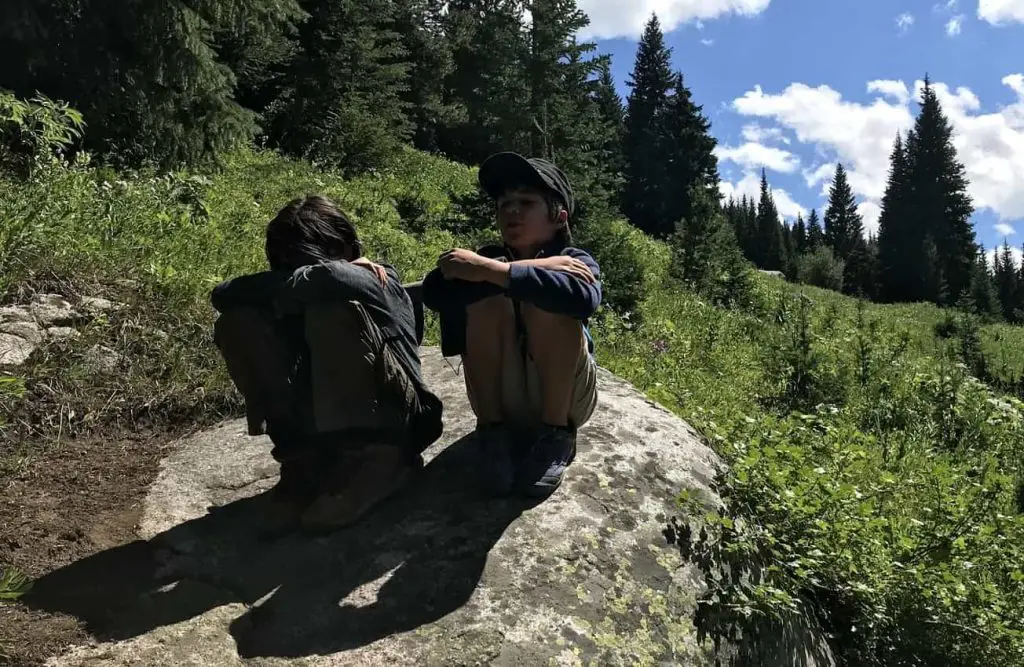There is a trend among hikers to move away from boots in favor of shoes. This is part of the minimalist movement across many activities, like barefoot running, or even barefoot hiking. If you are considering buying footwear for hiking you might be caught up in this dilemma yourself. Do I really need boots to hike?
Hiking is essentially walking along a path in the wilderness. Therefore, hiking boots are not strictly necessary. Hiking boots are indicated in certain situations, such as on longer hikes or if you are carrying a heavier backpack.
If you are still interested in whether hiking boots might be best for you, this post covers nine reasons why hiking boots beat out shoes.

1. Hiking Boots Provide Added Stability.
Perhaps the number reason why you would opt for hiking boots over hiking shoes or trail runners is if you are hiking on rough terrain. Boots provide superior stability for your feet and lower legs which helps prevent injury and also reduces fatigue.
You may think that hiking shoes are more comfortable and require less time to be broken in.
Modern hiking boots can be extremely comfortable straight out of the box. I have a pair of Danner Mountain 600s that I used for only a month before a four-day hike in Peru. The Mountain 600s were ‘broken in’ from day one. I never had an issue with blisters, hot spots, or stiffness in the boots. You can read my review here.
When you are hiking over rough, uneven terrain, boots can keep you from rolling your ankles more than shoes can. Boots are the best option if you need more support, especially if you plan to hike long distances.
2. Hiking Boots Help Stave Off Fatigue.
Boots are designed to provide more support than shoes. Hiking boots usually have a shank in them between the insole and the outsole, which diminshes the load put on your lower leg and your foot while walking. Shanks are less common in shoes.
The over-the-ankle design of boots provides more contact between the boot and your lower leg and foot. This means there is a greater surface area to distribute more of the forces acting on you while walking. This is especially important when you are climbing, descending, twisting, or turning while placing your feet on a hike.
Your boots will do more ‘work’ for you as you step on, over, around, or through rough, uneven terrain. This support may not seem important until you have been walking for hours and then the benefits become tangible. With shoes, you are relying more on the muscles in your feet and lowers legs for providing stability. Overtime this exertion can lead to fatigue. With boots, your feet work less.
In Peru, one of our guides wore hiking shoes on a four-day hike at Ausangate, but he hikes professionally and was jogging and skipping over boulders and around rocks like a mountain goat. This means that his lower legs and ankles have very developed stabilizer muscles to keep his feet and lower legs in position.

3. Hiking Boots Keep Out Debris.
Hiking boots are taller than shoes, and because of this, you will get much less debris in your boots than you will with shoes. Keeping debris out of your footwear while hiking will reduce the risk of injury from abrasion that can cause blisters to form. Comfort means less stress and less exertion over the distance of your hike.
In any case, a build-up of small debris from the trail is a nuisance. You will have to stop and remove this from your shoes more often than you will your boots. Once you get tired, you will tend not to notice the dust and dirt as much, and you will keep trudging along, increasing the chance of abrasion to your feet.
The added height of boots over shoes works in two ways to keep out debris. Since the top of the boot is above your ankle, the opening tends to fit more snuggly than shoes. Your pant legs will also tend to be down over the boot’s top more than they will a shoe. This means less debris and less hassle.
4. Hiking Boots Provide More Protection.
If you banged your ankle on a rock, would rather be wearing boots or shoes? Of you course, you would want boots. When I go hiking I never plan to get cuts and scrapes but it does happen.
Deserts, forests, jungles, and frozen fields all have elements that you need to navigate while walking. Whether you are stepping through the brush, clambering across scree at the base of a cliff, or punching through ice-covered snow, boots give you more protection in than shoes.
Small plants with thorns can be a real nuisance if you have exposed ankles.
Boots protect your lower legs and allow you to hike through rougher terrain than if you only had shoes on. Boots provide a hiker with a little more peace of mind. A minor scrape or scratch is not a big deal until you also have a headache, a blister, and are lost. Small injuries pile on top of each other to create real stress for any hiker.
5. Hiking Boots Descend Hills Better.
While hiking, one of the stressors on your body that can be difficult to train for is descending steep hills. Your feet tend to be shoved to the front of your shoe as your weight shifts from the full length of the bottom of your foot to the front of your foot.
While hiking down a steep grade, boots beat shoes because they distribute more of the load than a shoe does. Boots tend to prevent your foot from slipping to the front because your lower leg is also pushing into the top of the boot.
And another reason why boots descend hills better is because of the first point: stability. As you descend, you will naturally tend to step with the sides of your feet on the downhill. This adds more lateral pressure to your footwear, and boots will beat shoes here too.
As you descend, you will be less likely to sprain an ankle; plus, your boot is doing some of the work for you by redistributing more of the load across your feet and lower legs. With shoes, there is less material in contact with your body and therefore more stress applied to your feet.

6. Hiking Boots Climb Hills Better.
We are starting to see a trend here. Essentially, boots are better for hiking if you want your footwear to do work for you. If you like the minimalist approach and have very developed stabilizer muscles in your feet and lower legs then shoes might be a great way to go.
For most of us though, boots simply provide more support and more assistance in getting from trail head to trail end.
This is also true in ascending steep grades. Because a boot is connected to your lower leg it exerts some mechanical advantage as you climb up a steep grade.
Boots usually have shanks in them, which alleviate some of the work that your feet and calf muscles need to do in ascending because of the added stiffness in the sole of the boot. It feels almost like spring as you place the toe of the boot and straighten your leg to propel yourself up the hill. With shoes, you do not get this effect.
Because of all the points listed so far, boots are better at preventing injury than are shoes.
7. Hiking Boots Keep Feet Dryer.
Wet feet on a hike will create all kinds of issues for you. Softer feet mean a greater chance for blisters. If you are on a multi-day hike, having blisters on the first day can ruin your trip unless you have a quality first aid kit and a high tolerance for pain.
Boots will generally keep your feet dryer by preventing infiltration of water through ambient moisture from vegetation, streams, puddles, etc. Again, having more material over your ankle means there is less chance for water to get inside your footwear.
With boots, the tops of your socks will stay dryer since they will be more protected. Wet socks can wick moisture down to your feet over time.
If you were wearing boot with a waterproof liner or a pair of shoes with a waterproof liner, which one would be better a preventing water from getting inside your footwear? Boots!
8. Hiking Boots Prevent Injury.
Because of all the reasons listed above, boots are better than shoes at preventing injury. Let’s face it. Boots provide more stability, which means you are less likely to slip, trip, or turn an ankle.
Because boots provide more support, they necessarily reduce fatigue. I usually get hurt when I am tired. Fatigue saps our energy and causes us to stop paying attention to minor details. At this moment, you take a wrong step and turn an ankle or slip and fall. Boots stave off fatigue, and because of this, they keep you safer.
Hiking boots are better than shoes at keeping out debris. If you have a build up of sand and dirt in your shoes you increase your chances of blisters. A blister is an injury that can deplete your will to keep walking.
Boots provide more protection than shoes for your feet and lower legs. You will be less likely to get cuts, scrapes, or bruises from the environment with hiking boots. A few cuts and scrapes do not matter until you are tired and lost. These added stressors make it more difficult to overcome true challenges that might present themselves.
Hiking along a flat path, taking in the beautiful vistas, is every hiker’s dream. The reality is that you’re often sweating profusely hiking straight up a mountain, or your thighs are burning as you descend a steep grade. In these cases, boots do much more work for you than shoes can. This extra support means that you can climb and descend more easily, which reduces your risk of injury.
Dry feet on a hike are essential for avoiding blisters and hiking boots do a better job at keeping your feet dry than shoes.

9. Hiking Boots Are Traditional.
There is a trend toward hiking shoes and trail runners. I have personally hiked in sandals. There is even a movement to hike barefoot. Despite these trends and a nascent idea that pros prefer hiking shoes, boots still rule and they are traditionally what people wear to go hiking.
The military plans for hikes with heavy backpacks over great distances. And on these hikes, the military wears boots. For all the reasons listed above, soldiers hike in boots to be more prepared once they arrive at their destination. They are less fatigued and less prone to being injured than they would be if they were wearing shoes.
If you are planning to hike long distances with a backpack then you are better off wearing boots. The enhanced stability and support will make it easier to carry a heavier load on your back.
Modern hiking boots are more sneakers than boot and they are often comfortable and supportive straight out of the box. I could play basketball in my Danner Mountain 600s. They feel that good and light.
If you cannot afford a pair of hiking boots certainly do not let that stop you from going on a hike. Hiking is essentially walking. Bring a pair of shoes that you find comfortable and enjoy your time in the great outdoors.
If you interested in a great pair of modern hiking boots with some traditional alpine design elements then you should consider the Danner Mountain 600s. I have a complete review of them on the recommended gear page.
The verdict? Boots beat out shoes for hiking. Yes, they are bulkier and perhaps less modern than hiking shoes but today’s technology has also made them lighter, more supportive, and more comfortable than they were in the past.

